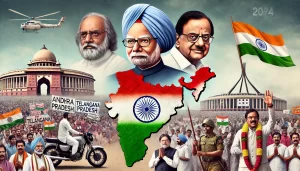The United Progressive Alliance (UPA) government, which ruled India from 2004 to 2014, had a complex and often contradictory relationship with the Telangana statehood movement. Its stance on the issue evolved over time, shaped by political calculations, public pressure, and internal divisions within the ruling coalition.
Initial Ambiguity (2004-2009)
When the UPA came to power in 2004, its Common Minimum Program (CMP) included the Telangana issue, signaling a willingness to consider the demand for a separate state. However, the government’s initial approach was marked by ambiguity and a lack of decisive action.
In 2005, the government formed The Pranab mukherjee committee to examine the Telangana issue and to recommend a course of action. However, the committee’s report was not made public, and the government remained non-committal on the issue.
This period of ambiguity was marked by growing frustration and disillusionment among the proponents of Telangana, who accused the government of delaying tactics and political expediency.
Announcement of the Telangana Process (2009)
In December 2009, following widespread protests and agitations in the Telangana region, the then Home Minister, P. Chidambaram, made a dramatic announcement that the process for the formation of Telangana would be initiated. This announcement was seen as a major victory for the Telangana movement and raised hopes for a swift resolution of the issue.
However, the government’s announcement was met with stiff resistance from the Seemandhra region (the remaining part of Andhra Pradesh). This led to political turmoil and widespread protests, forcing the government to put the Telangana process on hold.
Appointment of the Srikrishna Committee (2010)
In February 2010, in an attempt to find a way out of the impasse, the government appointed a committee headed by Justice B.N. Srikrishna to examine the demand for Telangana and to suggest a course of action.
The Srikrishna Committee submitted its report in December 2010, outlining six Options, including the creation of a separate Telangana state with Hyderabad as its capital. However, the report did not provide a clear recommendation, and the government again found itself in a dilemma.
Political Gridlock and Protests (2011-2013)
The period from 2011 to 2013 was marked by political gridlock and escalating protests in the Telangana region. The government’s indecision and perceived lack of commitment to the Telangana cause led to growing frustration and anger among the people.
The Telangana Rashtra Samithi (TRS), the main political party spearheading the movement, intensified its agitation, calling for strikes, bandhs, and protests. The movement also saw the emergence of new leaders and organizations, who employed innovative tactics to pressure the government.
Decision to Bifurcate Andhra Pradesh (2013)
In July 2013, after months of intense deliberations and political maneuvering, the Congress Working Committee (CWC), the highest decision-making body of the Congress party, finally decided to bifurcate Andhra Pradesh and create Telangana as a separate state.
This decision was seen as a major victory for the Telangana movement, which had been fighting for statehood for over five decades. However, it also sparked protests and violence in the Seemandhra region, where people opposed the division of the state.
Passage of the Andhra Pradesh Reorganization Act (2014)
In February 2014, the bill for the bifurcation of Andhra Pradesh was passed by the Lok Sabha (the lower house of Parliament). The bill was then passed by the Rajya Sabha (the upper house) in a controversial voice vote, amid uproar and protests from the Seemandhra MPs.
The bill received the President’s assent on March 1, 2014, paving the way for the creation of Telangana as India’s 29th state on June 2, 2014.
Assessment of the UPA’s Role
The UPA government’s role in the Telangana movement was a complex one. While it ultimately facilitated the creation of Telangana, it was also accused of delaying tactics, political expediency, and insensitivity towards the aspirations of the people of Telangana.
The government’s initial ambiguity and reluctance to take a decisive stand on the issue fueled the agitation and led to years of political turmoil and social unrest. Its decision to bifurcate Andhra Pradesh, though welcomed by the people of Telangana, was seen by some as a belated and politically motivated move.
Despite the criticisms, the UPA government’s decision to create Telangana was a landmark event in Indian history. It marked the culmination of a long and arduous struggle and fulfilled the aspirations of millions of people.
